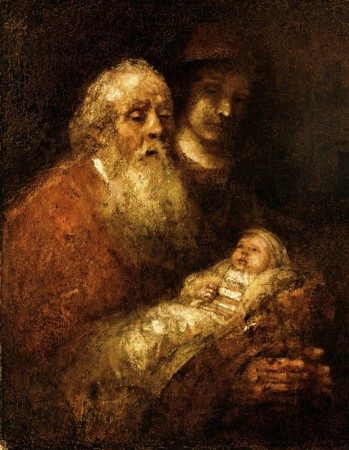In this wonderful season of the year, one of my favorite characters is Simeon (cf. Luke 2:22-35). I love this old man. The rhythm of his life, it seems to me, captures the rhythm of the season, as it flows from Advent to Christmas and on to Epiphany.
Prior to the episode recorded in Luke, Simeon’s life was an Advent sort of season – a long “waiting for the consolation of Israel” (2:25). The “consolation of Israel” was the Messiah; Simeon was awaiting his Advent.
Then, of course, came Christmas: Simeon met the Savior of the world, laid into his arms in the Temple in Jerusalem (v.28). And an Epiphany season followed immediately. Simeon recognized in the Blessed Child “a light for revelation to the Gentiles” (v.32). And the light moved him to sing out the good news.
Luke tells the story with careful attention to detail – somewhat peculiar details, in fact, that are not well captured in modern translations. Many translations tell us, for example, that Simeon “took Jesus up in his arms” when he appeared with his parents in the Temple (v.28). But there is no “taking up” in this passage; Luke uses the verb dechomai – a word that is often translated to welcome or receive, as you might receive a gift or a guest. And Simeon received the Savior into his ankalas – not his “arms,” literally, but the crook of his elbows.

Do you get the picture? Simeon “takes up” nothing at all in this encounter. He only receives. In fact, his hands are not involved in this encounter at all. He does not grip or grasp. He does not lift or carry. He is only open. The Savior is placed into his open arms.
I have recently examined a dozen alternative translations. Only the American Standard Version (1901) gets it right: “Then [Simeon] received him into his arms.” Interestingly, Rembrandt van Rijn gets it right, too. His famous depiction of Simeon shows exactly this sort of “receiving” – a faithful, believing reception into the crook of Simeon’s arms.
The rhythm of Simeon’s life should teach us something about the rhythm of our own. Sometimes, I think, we rush into Epiphany too quickly. We are eager to sing the praises of the “light for revelation to the Gentiles.” We are eager to take up the cause of Christ’s mission. We are eager, perhaps, to get on our way to the nations, or to begin language school, or to move ourselves to Mexico or Mongolia, let’s say. And in our rush to Epiphany, we sometimes burn out.
Before rushing to Epiphany, we need to sit for a while in the temple with Simeon. We need to yearn, a little, for “the consolation of Israel” – the unique, divine, heaven-provided answer for the aching sin of the world. And we need to open our arms and receive as a guest the Savior of the world. We cannot grasp him by our intellect or “take him up” by force of will. The Savior of the world is placed in our arms by grace through faith. We can only receive.
Only then, when we have received him, are we are prepared to engage in Epiphany. Only then are we given a song to sing, and some light to share, and a place in the mission of God in the world. A passion for mission is not engineered, somehow, by our clever strategies. It is caught, or given, or believed, as the Savior of the world is placed by grace into our lives. We receive him. And then we are invited to Epiphany.